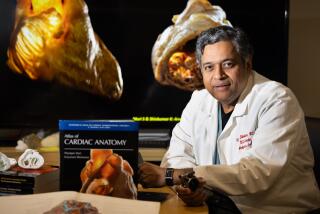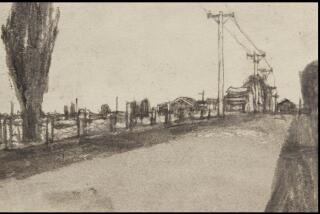Drawing Blood . . . and Other Body Parts
- Share via
At first glance, the picture resembles something vaguely familiar and human-like. But the jumbled mess of organs, bones and teeth only begins to make sense when deciphered by Allen Levinson, a medical illustrator by trade and somewhat of a historian on the subject.
“See, here’s the vagus nerve, the uvula and the vertebrae,” he said, pointing to each item authoritatively. “Educationally, it’s hard to identify this stuff. It’s too raw, too sinewy.”
What he’s showing a reporter is a drawing of a throat cut open and stretched upward by a piece of cloth tied through the jawbone. It’s a 1697 copper plate engraving Levinson picked up in Paris a few years back. The artist is Govard Bidloo, a Dutch anatomist, surgeon and court physician to England’s King William III.
“This is like anatomy bondage,” he said. “Bidloo had a blazingly naturalistic way of illustrating this stuff.”
Levinson received a bachelor’s degree in fine arts from the Art Institute of Chicago and tried his hand at commercial art for a few years before moving into medical art.
“Commercial art wasn’t for me,” he said. “Painting beads of sweat on Coke cans wasn’t very fulfilling personally. As art, it wasn’t very informative.”
Levinson enrolled in the University of Illinois’ Master’s of Associated Medical Sciences in Medical Illustration program in 1989. As one of the top schools for medical illustrators in the country, its first-year students follow the same curriculum as first-year medical students, even down to the dissection and examination of cadavers.
Levinson was recruited by ACE Medical Co. in 1994 and moved to Los Angeles. There, he illustrated the company’s screws, plates, intramedullary rods, cervical traction systems and other devices used in orthopedic surgery and bone reconstruction. His digital renderings were incorporated into printed materials, videos and computer-based training produced by the marketing department.
“The computer is great for a lot of repetitive work,” said Levinson, who has a Power Computing Macintosh clone with Photoshop, Illustrator, Fractal Design Painter, Strata StudioPro and various other drawing and 3-D programs. “Once you get one surgical view down, you just drop the instruments on top of it. If I were using traditional drawing techniques, I’d have to draw the exact same thing over and over.”
Salaries of digital medical illustrators are about the same as those who use traditional drawing techniques, according to Levinson. The job market for either type of illustrator is small but healthy, with opportunities available at teaching institutions, in publishing houses, within the medical-legal arena doing courtroom graphics or with pharmaceutical and medical-device manufacturers. The salaries at teaching hospitals and colleges tend to be lower than in private industry, where experienced contractors may earn as much as $70,000 annually, but the environment is much more stable.
Levinson, in fact, lost his job at ACE in December when the marketing department was downsized after ACE was acquired by another manufacturer of orthopedic implants. Since then, Levinson returned briefly to the world of commercial art, working on the promotional poster for the action movie “The Saint.”
“ ‘My-Allen-goes-Hollywood’ period,” he says. He recently picked up a full-time job illustrating and designing corporate computer-based training, and he is expanding his opportunities as a freelance medical illustrator.
“As long as medical care is necessary,” he said, “medical illustrators are going to participate.”
More to Read
The biggest entertainment stories
Get our big stories about Hollywood, film, television, music, arts, culture and more right in your inbox as soon as they publish.
You may occasionally receive promotional content from the Los Angeles Times.










